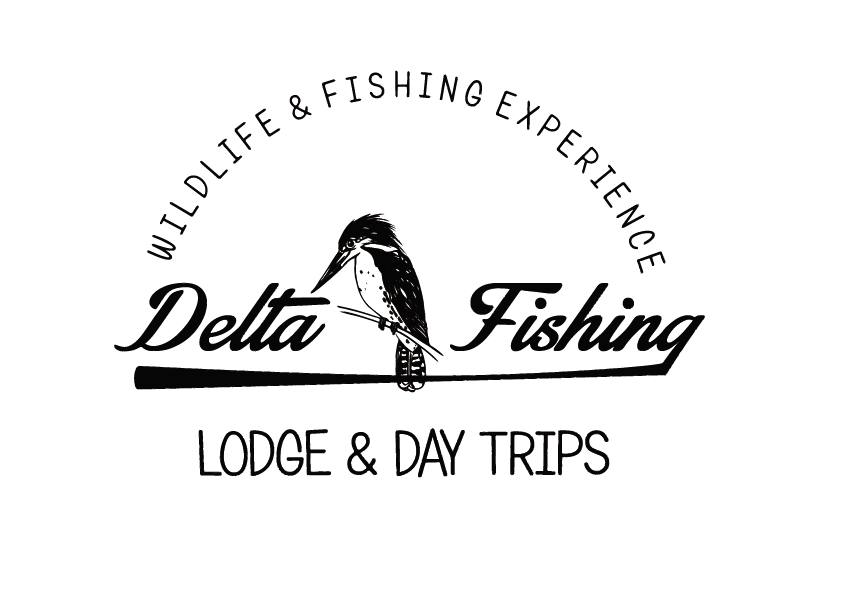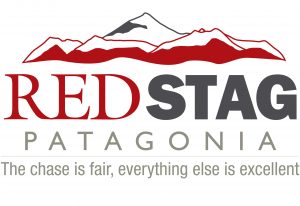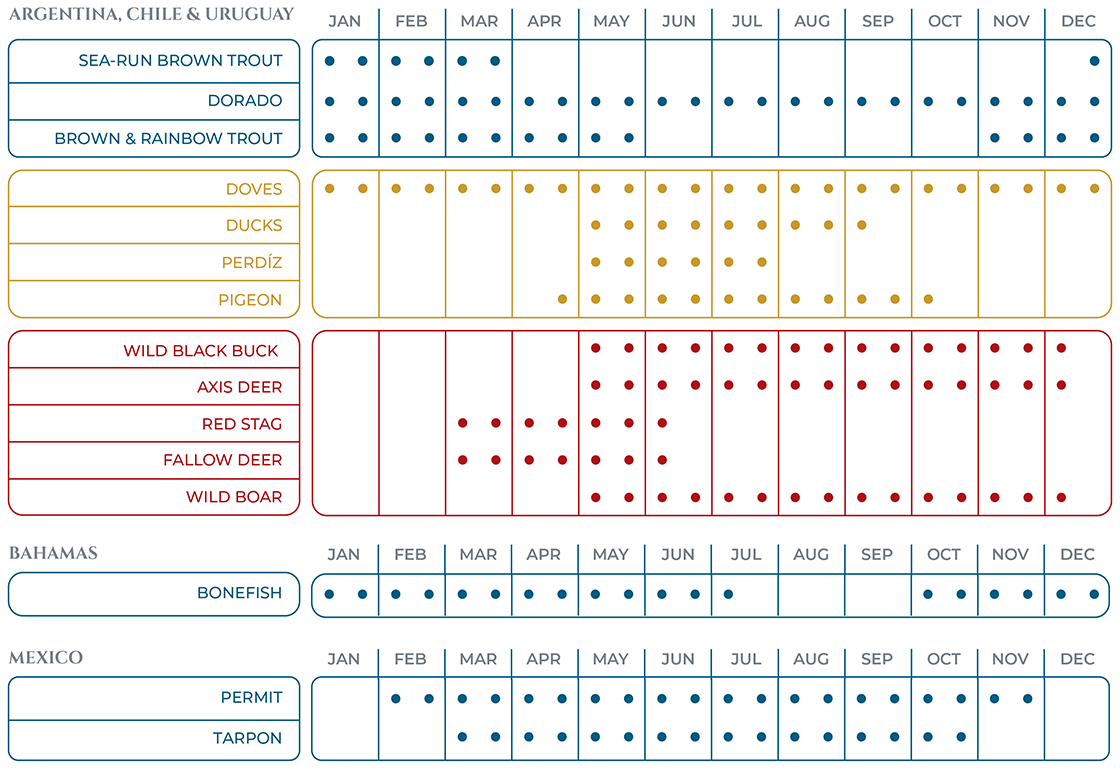What time of the year should I come?
In the angling front, the area of the lower section of the Paraná Delta and the inner sector of the Rio de la Plata estuary offers two very different seasons and two transitional ones with hints of both.
By late August, the first signs of rebirth start to show in the willows. Cold fronts still around, but, in between them, you can hear at night those creatures that remained quiet for a few months. Frogs, bugs, and birds that have been out of sight for a while, play their part as, in the waters, some sporadic rings and splashes are distinctly not being produced by carp or winter species. The greedy Bogas are usually one of the first warm-water species that show up in the scene, reminding us why their fighting skills are so appreciated. Some Dorados that remained in the area year-round instead of migrating up north during the mid-fall in search of warmer waters, start coming out intermittently from their lethargic mood, when they barely feed and with minimum effort, not very interested in chasing a swimming creature, much less an artificial one. The Tarariras, although still a bit drowsy, leave the bed they’ve made in the muddy bottoms of the streams and lagoons and, while being too lazy yet to come and eat in the surface for a few more weeks, they might attack without hesitation anything that swims nearby them in the depths. Some sunny afternoons you might even spot the first ones of the season in the shallow banks, like trying to get as close as they can to the sun to get some warmth in their bodies. Even so, it’s still, until late September, the time of the year when one of the most popular gamefish in Argentina – and practically unknown outside the country- is the center of attention for devote anglers: The Pejerrey. The area is, without question, the meca for this migratory species that represents like no other the art of fishing with floats.
Winter-time angling in this waters has always been a pleasure only known by the local enthusiasts. The reasons are many and come from different sources, but I suspect that more than anything else, they lie in the combination of lack of exposure and the general decreasing inclination towards the most Waltonian ways to enjoy fishing. A most truthful and real path indeed. Pejerrey fishing with floats in the mighty Río de la Plata can bring us anglers down to earth in style, and shake off all that patina of superficiality and emptiness that modern times are so capable to shower on us through an endless army of websites, magazines, social media, and silly “influencers”. That’s a lot to say about a species that very seldom reaches 4 or 5 pounds. It only takes a true angler, seasoned or novice, to understand why. The subtle charms and fascination that fishing with a float can produce in many of its versions quite often take us to that care-free limbo where the adult and the child are not so distant. In the utter absorption that this gentle art involves, staring at those gracefully shaped silhouettes and the waters around them, its sometimes easier to find that wealth of romance that is often taken for granted in the higher forms of angling but, in reality, it’s not always there – to say the least-. As a fly-fishing angler and guide for most of my life, it still surprises me when I find fly fishermen acting with certain superiority to the fisherman who delights even a proper approach to this quintessential branch of the sport. Some of the finest anglers I´ve met through the years are beyond that limited view and measure their appreciation in terms of how “Complete” a fisherman can be. There is a reason why Isaac Walton´s masterpiece title is probably the most powerful title in fishing literature since it was first published in 1653.
Back to the fishing in the area through the year, in September, early or late depending on the weather conditions, those floating lines might attract dorados too, and not only the bait on the hooks, but the floats themselves. They, every once in a while, take them for an injured minnow drifting helplessly on the surface and show no mercy on them, leaving their teeth marks and even breaking those beautiful balsa floats in half. A scene that you want to avoid and enjoy at the same time.
The changes happen quite fast in September, and in a matter of days, the air gets thick with the smell of flowers as the Pejerreyes start to leave the estuary already spawned until next April or May. By early or mid-October, their absence is practically complete. Now the scenery reached a point of transition that open the gates for another game. A game of diversity. The whole system gets unleashed to receive an impressive number of warm water species. While Dorados, Tarariras, and Bogas are the classic springtime, summer, and early Autumn presences, there is a string of species that randomly might appear and vanish in their encrypted dances with the tides. Because, yes, although the brackish and salt waters appear almost 200 kilometers downstream in the system, there are four tides a day. And since the estuary where this delta flows into, it’s mostly relatively shallow and extremely wide, those tides are very affected by the wind direction and strength. In some cases, the water level can reach a difference of several feet in a day. This multifaceted display of conditions is, in my opinion, one of the highlights of this fishery. The whimsical factor of surprising appearances and changes. Surprise. As we evolve as anglers, the feeling that such a word describes, often becomes somehow a bit dull in comparison with the early and innocent fishing experiences, losing part of its magic.
Only this particular section of the whole basin has tides. It is as dynamic and pulsating as a place can be. And this goes directly way deep in the flow of fish and their behaviors. On top of that, the types of waters an angler can visit in a day goes from tiny to huge, deep and shallow, clearer and darker, sand bars, rocks, lagoons, jungle streams, open flats… except for a freestone you might find practically everything without covering long distances. Such eclecticism is probably the main reason why at a certain point of my guiding life I decided to drop the anchor here -where I started many years ago- and settle down for good. It has ups and downs, like any fishery (at least the interesting ones), but, as a place to guide, keeping the mind open enough, it’s by far the most dynamic, complete, and fun I’ve ever experienced.
In terms of dorados, you can hardly catch a giant one in the area, but their range of moods and behaviors is, in general, wider than anywhere else because of the characteristics of the area. Although they might appear, 20 plus lbs dorados are exceptional. The approach and fishing techniques are as fine as they get: all floating lines -and many times even floating flies, like poppers, divers, and mice imitations. For lure fishing enthusiasts, these sorts of waters, because of their diversity in terms of structure, present a most enjoyable scene.
On the flip-side, most of the other species get as big as they get. It is probably the most consistent place to catch the biggest Tarariras in the country, with the bonus that is one of the only outside Uruguay where you might be lucky enough to find the elusive and glorious Tararira Azul, a subspecies’ known for their impressive sizes and fighting capacity. The lower section of the Paraná Delta and the first kilometers of the Río de la Plata, are also where the chances for seriously big Chafalotes are higher than anywhere else. Seriously big meaning 3 plus feet. Occasional and rare, these ghosts randomly let us know they do exist. And what a dreamy scene they offer when they take a fly or a lure. Besides the mentioned species, from late November to mid-April, these waters are regularly visited by Manduva, Manduví real, Pirá Pitá, Surubí, Cabeza Amarga, Pico-Pato, Lacha, many different kinds of catfish… the list is long. Some of them can be caught on a fly, some with lures, others with bait. All of them are interesting. Many of our guests enjoy fishing for them right at the lodge, after the daily sessions. Our home pool and docks are literally a few meters away from the rooms and dining room, so at any time anybody can grab a rod and do some fishing while having a drink, smoking a cigar, or even having dinner right there in case the bite is on. My favorite approach at night is fishing with floats. With the dock lights on, you can see all-around easily. It’s really cool. For those who love coarse fishing, it can be quite amazing. A separate paragraph deserves one of the fine angling’s most underrated subtleties: ultralight fishing. Either with flies or spinning -personally, I enjoy spinning even more in this case-, It’s all about the beauty of a number of species that randomly can be found in the area. There is definitely some appeal about those species or juvenile fish that somehow looks like living pieces of jewelry, just like the items we can use to catch them.
That brings us to the Fall. Probably the most exciting time for this type of fishing on the side, alternating it during the search for dorados. Autumn is not only when more species might appear in the same session, but also a scenic pleasure hard to forget in the Paraná Delta. All the colors between yellow and red at the banks, the leaves quiet in the waters, that suddenly move in waves as a fish takes and starts fighting. Some of those scenes remain in my memory up there, with some biggies, and I wouldn’t be able to choose. That’s the secret about finding real pleasure in fishing when truly the full context is even more important than the size of a fish, and the endless desire of finding both accomplishments together. Those special occasions when fishing invades the body through the pulse. I have a good recollection of sharing moments like those with guests and friends through the years at Delta Lodge. The mist and fog on some nights and mornings of April let us know that winter is around the corner. And by the end of the month, we start playing around again with the winter-fishing bags that were inside a box, a piece of furniture, or even under the bed. Fouling around daydreaming as we play with floats and lines and hooks, craving for the return of the Pejerrey runs. The transition is kind and never left us with a blank period of no fish in between. The summer species only leave the scenery for good when the Flecha del Plata (Silver Arrow in Spanish, as we nicknamed them in Argentina for almost a Century) arrive in numbers to makes us anglers desire the winters too. Desire not only for the fishing itself but also for those returns at twilight time, craving for a drink by the woodstove, revisiting, and sharing moments of the day.
It is mid-springtime as I write these words and I already miss that feeling, but, fortunately not too much, since I’m literally hearing dorados chasing minnows from my desk.
This intent for a rendezvous through the times of the year at this place ends almost where it began. A perpetual string of transitions in a most dynamic ecosystem, so pulsating in its core and character that affects all the fish that live in it to a point that makes them show a spectrum of behaviors rarely seen anywhere else. That is the essence of the tidal part of the basin, where the very same thing that represents a challenge is a major part of the attraction and what keeps it so wild being one step away from one of the largest cities in South America. A rare corner of the world outspread for us to learn and keep growing as anglers through the hypnotic rhythm of the flow.
Noel Pollak, Co-owner and manager.






